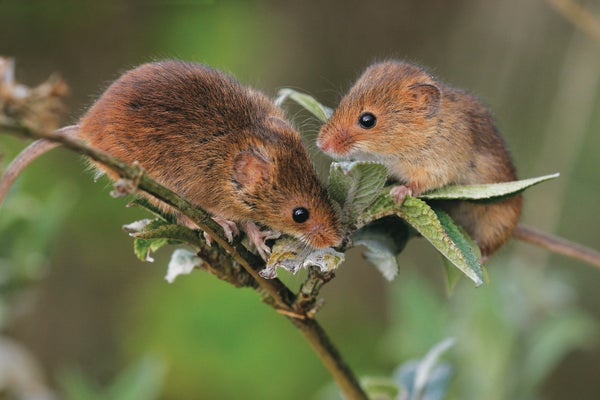Researchers have manipulated chromosomes inside a stem cell to produce mice with two biologically male parents. Stem cell biologist Katsuhiko Hayashi of Japan's Osaka University and his team say they are the first to turn a stem cell from an adult male mouse into an egg cell. Their technique, described in Nature, is a variation on what scientists call in vitro gametogenesis. In this process, researchers create gametes (sperm and eggs) from induced pluripotent stem cells—unspecialized cells derived from body tissue that researchers can convert into blood cells, neurons or almost any other cell type. The successful results raise intriguing thoughts about the possibility of men someday having biological children together, but researchers emphasize that any such attempt remains a long way off.
Earlier techniques for creating egg cells began with stem cells from a female animal. But Hayashi and his group used stem cells from a male mouse instead, discarding the Y chromosome and duplicating the X chromosome. Next they embedded an altered stem cell in an artificial ovary that was also produced from stem cells; the cell eventually developed into an egg cell, or oocyte, which could then be fertilized with sperm from a male. Hayashi and his colleagues transplanted 630 embryos grown from such egg cells into surrogate female mice. This resulted in seven live pups that grew normally, Hayashi said in a recent presentation at a London gene-editing summit. One male and one female pup were tested and proved fertile as adults.
“I think it's clearly very preliminary research,” says Evelyn Telfer, a reproductive biologist at the University of Edinburgh, who was not involved in the study. She says she found the work compelling and appreciates the insight it offers into how organisms reproduce. Telfer is concerned, however, by how few of the artificial egg cells grew into living mice. “Although they get quite a lot of eggs, these eggs are clearly not fully competent because they really get a very, very small proportion of them that are capable of being fertilized and forming embryos,” Telfer says—and she notes that following the living pups' health and development will also be crucial. “There's a lot of work that has to be done.”
On supporting science journalism
If you're enjoying this article, consider supporting our award-winning journalism by subscribing. By purchasing a subscription you are helping to ensure the future of impactful stories about the discoveries and ideas shaping our world today.
Attempting the technique in people would be significantly more difficult, as Hayashi noted during his presentation. “There is a big difference between a mouse and a human,” he said.
Human cells develop much more slowly than mouse cells do, and scientists have honed advanced processes for artificial mouse reproduction in the laboratory, Telfer says. For human cells, these systems aren't as developed. Telfer notes that in her own work, which relies on natural precursors to human egg cells, successfully growing mature gametes remains challenging.
“I think we're at a stage where the mouse work is fabulous, but moving this area along to other species has proved to be a lot more difficult,” she says. “There are challenges at every stage.”
And researchers have not yet successfully produced human egg or sperm cells from stem cells, says biomedical scientist Kotaro Sasaki of the University of Pennsylvania School of Veterinary Medicine, who has worked with Hayashi in the past. “In humans, we're still so behind,” Sasaki says, although he suggests that it might be technically feasible to produce human gametes one day—perhaps within a decade.
Additional research would be needed to mimic in humans the chromosome-swapping feat that sets Hayashi's new work apart. Sasaki expects that deleting Y chromosomes and duplicating X chromosomes wouldn't go nearly as smoothly in human cells. Hayashi's team used a compound that encourages chromosomal changes, and Sasaki says using the same approach in humans could cause many additional mutations, some of which could be harmful to the growing organism.
Sasaki also would like to see Hayashi's technique tested in monkey cells before those of humans—and certainly before scientists create any human embryos. He cautions that some safety issues could become apparent only in a second generation. “Using this for reproductive purposes ... comes with lots and lots of ethical and legal issues, which we need to seriously address,” he says.
During his presentation's Q&A, Hayashi specifically referenced only Turner syndrome (a rare infertility-associated condition in which cells that would typically contain two X chromosomes have only one) as a potential human-use case for the technique. But if it becomes viable, the process might have higher demand for facilitating childbirth for LGBTQ+ people, says Telfer, who works with people with Turner syndrome.
I. Glenn Cohen, a law professor at Harvard Law School who specializes in medical ethics, says that the new research suggests society as a whole needs to have conversations—sooner rather than later—about in vitro gametogenesis, its regulation and its ethical implications.
The way that the technique could open reproduction to couples who do not have an XX-XY chromosomal pair raises a unique question, Cohen says. “To what extent does [in vitro gametogenesis] represent the ultimate for equality for same-sex couples?” he asks. “Should this become technologically feasible for human beings, should same-sex couples have a right to do so?”
